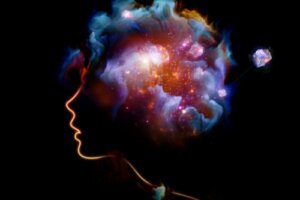Imagination Quotient: Creativity Will Soon Be Measurable


Written and verified by the psychologist Valeria Sabater
Daydreaming involves immersing yourself in a parallel world of infinite possibilities. It means mentally playing with new and almost impossible ideas, and unusual scenarios and experiences. We mentally create projects and shape stories and see ourselves in future situations in which we feel happy and self-fulfilled.
Jules Verne said that “anything one man can imagine, other men can make real”. In fact, much of what surrounds us today previously belonged to the vast universe of the imagination. Buildings, technological engineering, books, and even medical treatments. Every advance is the result of a concept that someone imagined at some point in time.
This explains why Albert Einstein considered that imagination is often more decisive than knowledge itself. It’s a way of broadening the mind to shape new possibilities that, sooner or later, may come to fruition. Consequently, it’s a construct of great relevance for the human being. Moreover, it’s one to which we should pay more attention.
The most useful imagination is the kind that follows a purpose and doesn’t only seek to make us escape from reality.

Imagination quotient
We’re all born with extraordinary creative potential. However, when we grow into adults, our imaginations wither. They’re still there, but we just don’t tend to access them too much. Somehow, we’re convinced that only children and the naive tend to daydream. It’s as if this practice lacks value and significance for us, as humans.
Sir Ken Robinson was one of the foremost experts on education. He used to say that schools kill creativity. Indeed, it’s true that our society and its educational methodologies don’t always take care of or promote this variable. This is rather a big mistake as well as a tactical tragedy. Because we’re facing a future full of challenges and need innovative people who can respond to the most varied of problems.
Therefore, imagination is an invaluable tool for our progress. It was for this reason that the Imagination Institute (Philadelphia) was created. The cognitive psychologist, Scott Barry Kaufman is its scientific director. Figures such as Martin Seligman and Robert J. Sternberg are also active participants. One of its future aims is to develop an instrument that measures the imagination quotient.
What’s imagination?
In 2016, the University of New Mexico developed an instrument to assess human creativity. The research claimed that imagination is a highly complex cognitive construct. It’s not daydreaming. It doesn’t mean just letting the mind wander, putting it in a state in which it feels totally comfortable. In fact, in reality, the brain is activating the most sophisticated mechanisms when we daydream.
Imagining involves activating episodic memory, performing mental simulations, and visualizations, putting future thinking into practice, and even navigating space. This process is mediated by regions such as the caudal/rostral medial frontal lobe, the hippocampus, the temporal lobe, and the nucleus accumbens.
This process that involves imagining, creating, mental wandering, and the manipulation of ideas, concepts, and possibilities is a natural exercise that we should practice daily. But, when we reach adulthood, our lifestyles don’t leave room for our imaginations and it’s at this point that our psychological constructs lose their potential.
The usefulness of an instrument to measure imaginative quotient
As we mentioned earlier, The Imagination Institute, funded by the John Templeton Foundation, aims to develop an instrument that measures the imagination quotient. The idea is for it to be oriented to all sectors of the population. Knowing what the individual’s potential is in this construct would allow multiple dimensions to be assessed.
According to those responsible for the development of this test, these are the areas to be evaluated:
- Pleasant reverie.
- Planning.
- Meaningful reverie.
- Inconsistency.
- Strange or fanciful dreams.
To demonstrate the importance of such an instrument, we only have to consider the fact that individuals with high anxiety and stress exhibit less imaginative capacity. What’s more, what they imagine almost always has a negative valence. Moreover, low imagination reduces our opportunities to solve complex problems or formulate new goals when some of them fail.
Being creative is a reflection of a flexible, optimistic, and focused mind. Having a resource to assess the imagination quotient would allow us to assess various areas of our mental health.
While being highly creative is highly beneficial for our well-being, excessive daydreaming (constantly taking refuge in the imagination) can be pathological.

Daydreaming day boosts your wits
The imagination quotient will be developed in the future. It’ll help us discover several things. We’ll be able to differentiate between the two types of daydreams, the useful and the useless kinds. The latter are those that get us nowhere, don’t allow us to achieve goals, and are often unpleasant. For example, those experienced by sufferers of anxiety or depression.
On the other hand, useful reverie is a pleasurable kind of daydream that relieves stress. It also acts as a mechanism for innovation and helps us achieve the goals we set for ourselves. Dreaming and imagining build bridges to our highest achievements and successes. This leads us to certain other aspects that we should bear in mind.
Daydreaming can be a daily investment with extremely interesting returns. Doing it isn’t wasting time, it means gaining ideas, hopes, and motivation. It’s letting our minds play, like when we were children and we believed that everything was possible. So, why not give it a try? Go back to your childhood, let your thoughts take flight, and have fun creating new possibilities.
Daydreaming involves immersing yourself in a parallel world of infinite possibilities. It means mentally playing with new and almost impossible ideas, and unusual scenarios and experiences. We mentally create projects and shape stories and see ourselves in future situations in which we feel happy and self-fulfilled.
Jules Verne said that “anything one man can imagine, other men can make real”. In fact, much of what surrounds us today previously belonged to the vast universe of the imagination. Buildings, technological engineering, books, and even medical treatments. Every advance is the result of a concept that someone imagined at some point in time.
This explains why Albert Einstein considered that imagination is often more decisive than knowledge itself. It’s a way of broadening the mind to shape new possibilities that, sooner or later, may come to fruition. Consequently, it’s a construct of great relevance for the human being. Moreover, it’s one to which we should pay more attention.
The most useful imagination is the kind that follows a purpose and doesn’t only seek to make us escape from reality.

Imagination quotient
We’re all born with extraordinary creative potential. However, when we grow into adults, our imaginations wither. They’re still there, but we just don’t tend to access them too much. Somehow, we’re convinced that only children and the naive tend to daydream. It’s as if this practice lacks value and significance for us, as humans.
Sir Ken Robinson was one of the foremost experts on education. He used to say that schools kill creativity. Indeed, it’s true that our society and its educational methodologies don’t always take care of or promote this variable. This is rather a big mistake as well as a tactical tragedy. Because we’re facing a future full of challenges and need innovative people who can respond to the most varied of problems.
Therefore, imagination is an invaluable tool for our progress. It was for this reason that the Imagination Institute (Philadelphia) was created. The cognitive psychologist, Scott Barry Kaufman is its scientific director. Figures such as Martin Seligman and Robert J. Sternberg are also active participants. One of its future aims is to develop an instrument that measures the imagination quotient.
What’s imagination?
In 2016, the University of New Mexico developed an instrument to assess human creativity. The research claimed that imagination is a highly complex cognitive construct. It’s not daydreaming. It doesn’t mean just letting the mind wander, putting it in a state in which it feels totally comfortable. In fact, in reality, the brain is activating the most sophisticated mechanisms when we daydream.
Imagining involves activating episodic memory, performing mental simulations, and visualizations, putting future thinking into practice, and even navigating space. This process is mediated by regions such as the caudal/rostral medial frontal lobe, the hippocampus, the temporal lobe, and the nucleus accumbens.
This process that involves imagining, creating, mental wandering, and the manipulation of ideas, concepts, and possibilities is a natural exercise that we should practice daily. But, when we reach adulthood, our lifestyles don’t leave room for our imaginations and it’s at this point that our psychological constructs lose their potential.
The usefulness of an instrument to measure imaginative quotient
As we mentioned earlier, The Imagination Institute, funded by the John Templeton Foundation, aims to develop an instrument that measures the imagination quotient. The idea is for it to be oriented to all sectors of the population. Knowing what the individual’s potential is in this construct would allow multiple dimensions to be assessed.
According to those responsible for the development of this test, these are the areas to be evaluated:
- Pleasant reverie.
- Planning.
- Meaningful reverie.
- Inconsistency.
- Strange or fanciful dreams.
To demonstrate the importance of such an instrument, we only have to consider the fact that individuals with high anxiety and stress exhibit less imaginative capacity. What’s more, what they imagine almost always has a negative valence. Moreover, low imagination reduces our opportunities to solve complex problems or formulate new goals when some of them fail.
Being creative is a reflection of a flexible, optimistic, and focused mind. Having a resource to assess the imagination quotient would allow us to assess various areas of our mental health.
While being highly creative is highly beneficial for our well-being, excessive daydreaming (constantly taking refuge in the imagination) can be pathological.

Daydreaming day boosts your wits
The imagination quotient will be developed in the future. It’ll help us discover several things. We’ll be able to differentiate between the two types of daydreams, the useful and the useless kinds. The latter are those that get us nowhere, don’t allow us to achieve goals, and are often unpleasant. For example, those experienced by sufferers of anxiety or depression.
On the other hand, useful reverie is a pleasurable kind of daydream that relieves stress. It also acts as a mechanism for innovation and helps us achieve the goals we set for ourselves. Dreaming and imagining build bridges to our highest achievements and successes. This leads us to certain other aspects that we should bear in mind.
Daydreaming can be a daily investment with extremely interesting returns. Doing it isn’t wasting time, it means gaining ideas, hopes, and motivation. It’s letting our minds play, like when we were children and we believed that everything was possible. So, why not give it a try? Go back to your childhood, let your thoughts take flight, and have fun creating new possibilities.
All cited sources were thoroughly reviewed by our team to ensure their quality, reliability, currency, and validity. The bibliography of this article was considered reliable and of academic or scientific accuracy.
- Chavarría, M. Á. (2015). La eficacia de la creatividad: Creactívate. ESIC Editorial.
- García-Ramírez, J.M. Predictibilidad y creatividad narrativa. ULU, 1: 1-6 (2015). [http://hdl.handle.net/10481/39368]
- Jung RE, Flores RA, Hunter D. A New Measure of Imagination Ability: Anatomical Brain Imaging Correlates. Front Psychol. 2016 Apr 18;7:496. doi: 10.3389/fpsyg.2016.00496. PMID: 27148109; PMCID: PMC4834344.
This text is provided for informational purposes only and does not replace consultation with a professional. If in doubt, consult your specialist.







